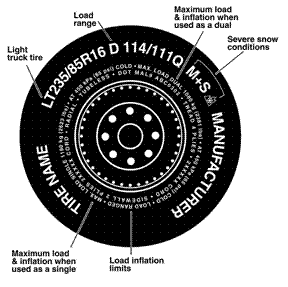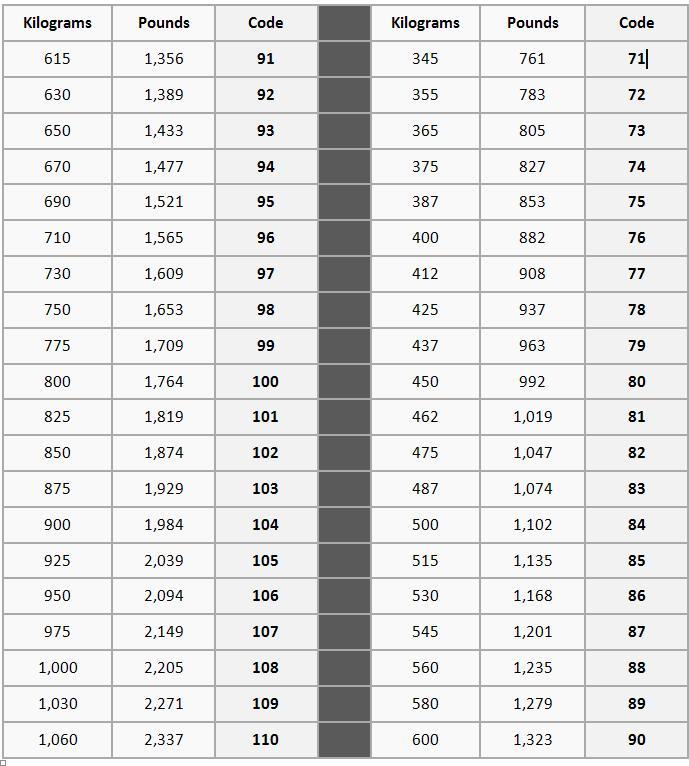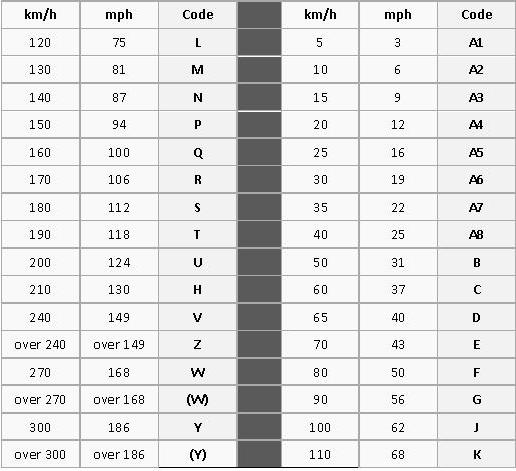[center]هذه المعلومات مأخذه من موقع ويكيبديا
http://en.wikipedia.org/wiki/Tyre_size
Automobile tires are described by an alphanumeric code which is generally molded into the side-wall of the tire. This code specifies the dimensions of the tire and some of its key limitations such as load bearing ability and maximum speed. Sometimes the inner sidewall contains information not included on the outer sidewall, and vice versa.
The code has grown in complexity over the years as is evident from the mix of metric and imperial units and ad-hoc extensions to lettering and numbering schemes. New automotive tires frequently have ratings for traction, treadwear, and temperature resistance (collectively known as The Uniform Tire Quality Grade (UTQG) ratings).
Most tires sizes are given using the ISO Metric sizing system, however some pickup trucks and SUVs use the Light Truck Numeric or Light Truck High Flotation system.
The meaning of tire codesThe ISO Metric tire code consists of a string of letters and numbers, as follows:
An optional letter (or letters) indicating the intended use or vehicle class for the tire:
P: Passenger
LT: Light Truck
ST: Special Trailer
T: Temporary
3 digit number: The width of the tire in millimeters, from sidewall edge to sidewall edge.
/: Slash character
https://i.servimg.com/u/f41/12/01/68/31/tireco12.gif

https://i.servimg.com/u/f41/12/01/68/31/tireco13.gif

2 digit number: The ratio of the sidewall height to the total width of the tire as a percentage. If this is missing, it is assumed to be 82%. If the number is larger than 200, then this is the diameter of the entire tire in millimeters.
Construction of the fabric of the tire: B: bias belt
D: diagonal
R: radial
2 digit number: Diameter in inches of the rim that this tire is designed to fit.
2 or 3 digit number: Load index; see table below.
1 or 2 digit/letter combo: Speed rating; see table below.
Additional marks: See subheading below.
Some light truck tires follow the Light Truck Numeric or Light Truck High Flotation systems, indicated by the letters LT at the end instead of the beginning of the sequence, as follows:
The tire diameter is given for High Flotation tires and omitted from Numeric tires.
2 digit number: The diameter of the tire in inches.
x: Separator character.
3 or 4 digit number: The section width (cross section) of the tire in inches. If the tire diameter is not given, section widths ending in zero (e.g., 7.00 or 10.50) indicate the aspect ratio is 92%, while section widths not ending in zero (e.g., 7.05 or 10.55) indicate the aspect ratio is 82%.
Construction of the fabric of the tire:
B: bias belt
D: diagonal
R: radial
2 digit number: Diameter in inches of the rim that this tire is designed to fit.
LT: Designates that this is a Light Truck tire.
Load index and speed rating are not required for this type of tire but may be provided by the manufacturer.
2 or 3 digit number: Load index; see table below.
1 or 2 digit/letter combo: Speed rating; see table below.
Additional marks: See subheading below.
Load IndexThe load index on a tire is a numerical code associated with the maximum load each tire can carry (i.e.: if the car is in perfect balance, each tire will hold one-forth the cars weight, however, cars are rarely ever in perfect balance).
Load Index
https://i.servimg.com/u/f41/12/01/68/31/load_i11.jpg
 Speed rating codes
Speed rating codesThe code is made up of one or two letters, or one letter and one number. It indicates the maximum speed that the tire can sustain for a ten minute endurance without being a danger.
Tire speed rating codes
https://i.servimg.com/u/f41/12/01/68/31/speed_11.jpg

Prior to 1991, tire speed ratings were shown inside the tire size, replacing the "R" character. The available codes were SR (112 mph, 180km/h), HR (130 mph, 210 km/h), VR (in excess of 130 mph, 210 km/h) and ZR (in excess of 149 mph, 240 km/h). The ZR code is still in common use, often combined with a W or Y speed code.
Tires with a speed rating higher than 186 MPH (300 km/h) are indicated by a Y in parenthesis. The load rating is often included within the parenthesis, e.g. (86Y).
In some countries, tires are required by law to exceed the maximum speed of the vehicle they are mounted on with regards to their speed rating code. In Germany, tires that are not fit for a car's or motorcycle's particular maximum speed are illegal to mount unless a warning sticker stating the allowed maximum speed is placed within clear sight of the driver inside the vehicle. Some manufacturers will install a speed governor if a vehicle is ordered with tires rated below the vehicle's maximum speed.
Additional marksThere are numerous other markings on a typical tire, these may include:
M+S: Mud and Snow; winter/all-weather tires with above-average traction in muddy or snowy conditions. Spike tires have an additional letter, "E" (M+SE).
BSW: Black SideWall
WSW: White SideWall
OWL: Outline White Lettering
E4: Tire approved according ECE-regulations, the number indicating the country of approval.
030908: Approval number of the tire
DOT code: All tires imported into the USA have the DOT code, as required by the Department of Transportation (DOT). It specifies the company, factory, mold, batch, and date of production (2 digits for week of the year plus 2 digits for year; or 2 digits for week of the year plus 1 digit for year for tires made prior to 2000)
TL: Tubeless
TT: Tube-type, tire with an inner-tube
Made in: Country of production
C: Commercial; tires for light trucks (Example: 185 R14 C)
B: Bias belted; tires for motorcycles (Example: 150/70 B 17 69 H)—diagonal construction with belt added under the tread
SFI: Side Facing Inwards; inside of asymmetric tires
SFO: Side Facing Outwards; outside of asymmetric tires
TWI: Tread Wear Indicator; a device in the main tire profile which shows when the tire is worn down and needs to be replaced
SL: Standard Load; tire for normal usage and loads
XL: eXtra Load; tire for heavy loads
RF: Reinforced tires
Arrows: Some tread designs are designed to perform better when driven in a specific direction (clockwise or counter-clockwise). Such tires will have an arrow showing which way the tire should rotate when the vehicle is moving forwards. It is important not to put a "clockwise" tire on the left hand side of the car or a "counter-clockwise" tire on the right side.
MO: Original Tires for Mercedes-Benz
To facilitate proper balancing, most high performance tyre manufacturers in addition place red (uniformity) and yellow (weight) marks on the sidewalls of its tyres to enable the best possible match-mounting of the tyre/wheel assembly.
Tire geometryWhen referring to the purely geometrical data, a shortened form of the full notation is used. To take a common example, 195/55R16 would mean that the width of the tire is 195 mm at the widest point, the height of the side-wall of the tire is 55% of the width (107 mm in this example) and that the tire fits 16 inch diameter wheels. The code gives a direct calculation of diameter.
Less commonly used in the USA and Europe (but often in Japan for example) is a notation that indicates the full tire diameter instead of the side-wall height. To take the same example, a 16 inch wheel would have a diameter of 406 mm. Adding twice the tire height (2×107 mm) makes a total 620 mm tire diameter. Hence, a 195/55R16 tire might alternatively be labelled 195/620R16.
Whilst this is theoretically ambiguous, in practice these two notations may easily be distinguished because the height of the side-wall of an automotive tire is typically much less than the width. Hence when the height is expressed as a percentage of the width, it is almost always less than 100% (and certainly less than 200%). Conversely, vehicle tire diameters are always larger than 200 mm. Therefore, if the second number is more than 200, then it is almost certain the Japanese notation is being used—if it is less than 200 then the U.S./European notation is being used.
ExampleThe tires on a Mini Cooper might be labeled:
P195/55R16 85H
"P"—these tires are for a passenger vehicle.
195—the width of the tire is 195 mm at the widest point.
55—indicates that the height of the side-wall of the tire is 55% of the width—107 mm.
R—this is a radial tire.
16—this tire fits 16 inch diameter wheels.
85—the load index, a maximum of 515 kg per wheel in this case.
H—the speed index, this means the maximum permitted speed, here 210 km/h (130 mph)
[center]

